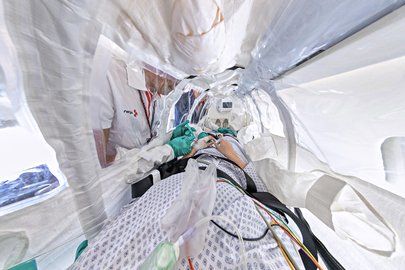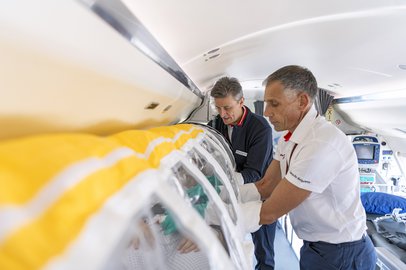Two people wearing blue protective overalls, gloves and face masks bend over a woman. She is lying in the open patient isolation unit (PIU) with a monitoring and ventilation machine on the ground next to her. A pilot is holding up an umbrella to prevent the woman from being blinded by the bright light. Twenty minutes and countless precisely prescribed and executed actions later, Rega flight physician Laura Arheilger closes the zip of the isolation unit and disinfects it from the outside.
Isolated in the Rega jet
Now the highly contagious patient with Covid-19 is completely isolated in the PIU and ready for the flight to Switzerland. Flight physician Laura Arheilger and intensive care nurse Barbara Locher carefully remove their protective clothing in a precisely prescribed order. Then the Rega crew push the patient up the ramp and into the ambulance jet. Shortly afterwards, the Rega jet takes off in the direction of Switzerland. After stopovers in Brazil and on the Canary Islands, it finally lands at Bern-Belp Airport. From there, the patient is taken by ambulance to the Inselspital in Berne. The fact that such transports can be carried out safely and efficiently is all thanks to Rega’s experience and innovative strength.
The time before the PIU
Before the introduction of the PIU, the Rega crews had to wear protective clothing throughout the flight when transporting patients with highly contagious diseases. Even the pilots in the jet cockpit wore protective garments and face masks. Drinking or eating in the plane was not possible. What was not an issue during short missions became quite a problem during long-haul flights. In addition, the entire jet had to be thoroughly decontaminated and ventilated afterwards – and during this time was not available to transport other patients.
Ebola epidemic provided the impetus
In 2014, reports of an Ebola epidemic of unprecedented proportions swept through West Africa. In August, the World Health Organisation (WHO) declared that the epidemic was a public health emergency of international concern. The situation made it apparent that until then hardly any reliable concept for transporting highly contagious patients existed worldwide. Rega Medical Director Roland Albrecht explains: “We have always regarded it as our task to be able to fly even highly infectious patients safely and efficiently back home for further medical treatment in an emergency.” This should therefore be possible not only in the case of Ebola, but also in similar cases in future, he says. Consequently, Rega set about looking for new solutions.
Total isolation during transport
Rega’s objective was to completely isolate contagious patients in an airtight protective unit for the entire duration of the transport, in order to eliminate any risk of all the people involved becoming infected and to enable the crew to move around in the jet without having to wear protective clothing. What sounded simple turned out to be very complex in practice: attending to the patient during the flight without opening the protective cover and thus breaking the isolation conditions, ensuring the supply of fresh air, or compensating the impact of a sudden loss of cabin pressure which causes the air in the hermetically sealed protective cover to suddenly expand were just some of the challenges that needed to be addressed during the development process.
Practical test during Ebola epidemic
The actual construction of the PIU was only one part of the overall protection concept. Equally important was and still is the entire procedure for isolating the patient and handling the PIU during use. After months of intensive development work, numerous trainings and trials, the acid test came on 19 February 2015: Roland Albrecht and his team flew a patient suspected of being infected with Ebola for the first time in the PIU, from Freetown in Sierra Leone to London. However, the abatement of the Ebola epidemic a year later did not mean that the PIU was no longer needed. “We explicitly developed the concept not only with the Ebola virus in mind, but also for highly infectious diseases in general,” says Roland Albrecht. “Transporting infectious patients is part of Rega’s standard scope of operations and we transport patients suffering from highly contagious open tuberculosis several times a year.” When the new coronavirus started spreading at the beginning of 2020, Rega was able to draw on its experience with the already tried-and-tested PIU. At the end of February 2020, Rega crews underwent special training on how to handle coronavirus cases and where necessary the procedures were adapted and practised. Since the beginning of the pandemic, Rega’s jet crews have transported more than 400 coronavirus patients in a PIU. Roland Albrecht draws a positive conclusion: “The concept has proven itself from the very beginning. In addition, over the last two years we have been able to continually improve the processes and finer details.”
Prototype of the PIU 2.0 in the making
With the experience gained from hundreds of missions, Roland Albrecht and his team have also come up with new ideas on how to further optimise the PIU. The focus is on even easier handling and more flexibility in use. The prototype of the PIU 2.0 is currently being implemented in line with the specifications of the design team and the drawings of the Rega engineers. Roland Albrecht aims to perform the first missions with the new, improved PIU by autumn 2022 – in order to fly patients with highly infectious diseases home even more efficiently and safely in future.
More information on our missions abroad
PDF: Illustration "The jet crew"



![[Translate to English:]](/fileadmin/_processed_/6/8/csm_RM98_S24_Annika_Hein_Arequipa_23.06.2020_13_7eac62b27e.jpg)